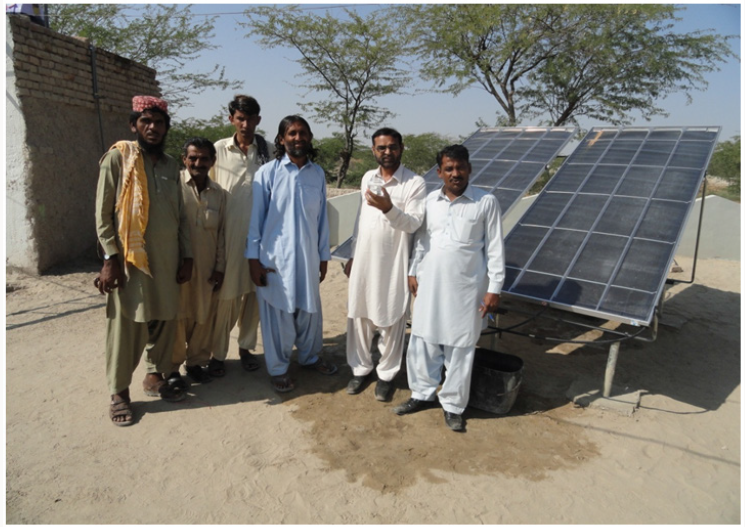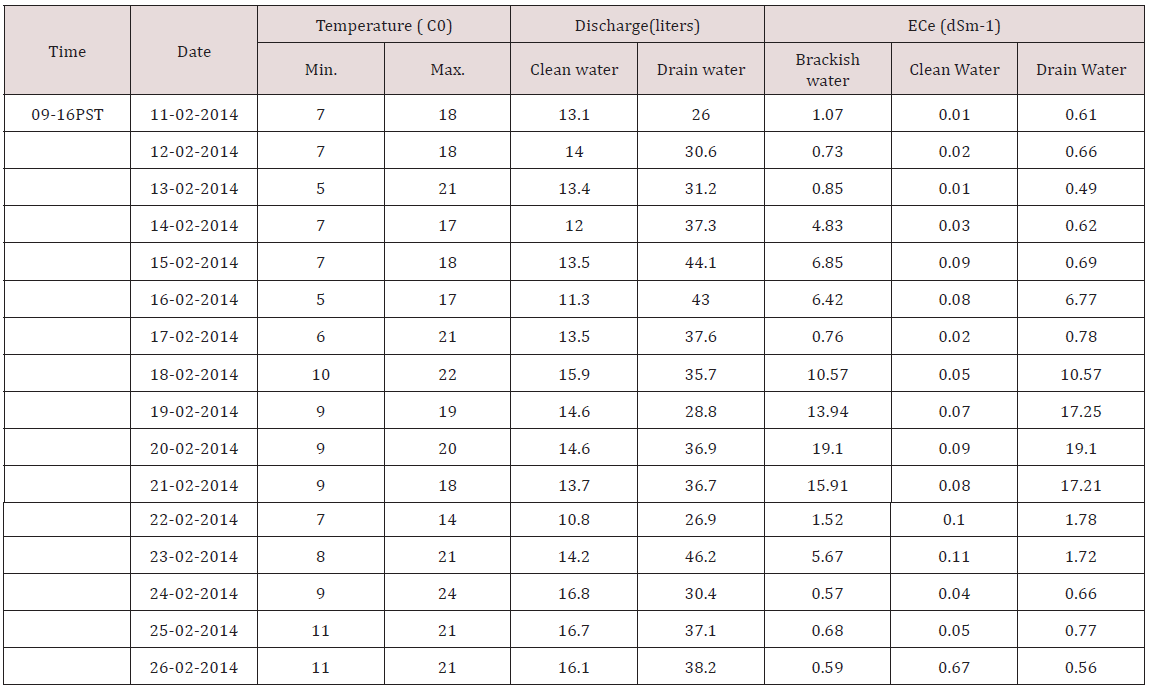Lupine Publishers |Agriculture Open Access Journal
The origin and continuation of mankind is based on water. Water is
one of the most abundant resources on earth, covering
three-fourths of the planet’s surface. Water is one of the earth’s most
abundant resources, covering about three-quarters of the
planet’s surface. The reason for this apparent contradiction is, of
course, that - 97.5% of the earth’s water is salt water in the oceans
and only 2.5% is fresh water in ground water, lakes and rivers and this
supplies most human and animal needs. It would be feasible
to address the water-shortage problem with seawater desalination;
however, the separation of salts from seawater requires large
amounts of energy which, when produced from fossil fuels, can cause harm
to the environment. Therefore, there is a need to employ
environmentally-friendly energy sources in order to desalinate seawater.
Solar distillation systems are increasingly attractive in the
areas suffering from shortages of fresh water but where solar energy is
plentiful and where operational and maintenance costs are
low.
Introduction
Water is essential for life. Many countries around the world,
especially developing countries and countries in the Middle East
region, suffer from a shortage of fresh water. The United Nations
(UN) Environment Programme stated that one-third of the world’s
population lives in countries with insufficient freshwater to support
the population [1]. Consequently, drinking water of acceptable
quality has become a scarce commodity. The total global water
reserves are _1.4 billion km3, of which around 97.5% is in the oceans
and the remaining 2.5% is fresh water present in the atmosphere,
ice, mountains and ground water. Of the total, only _0.014% is
directly available for human beings and other organisms [2]. Thus,
tremendous efforts are now required to make available new water
resources in order to reduce the water deficit in countries which
have shortages [3]. According to World Health Organization (WHO)
guidelines, the permissible limit of salinity in drinking water
is 500ppm and for special cases up to 1000ppm [4]. Most of the
water available on the earth has a salinity up to 10000ppm and
seawater normally has salinity in the range of 35 000-45 000ppm
in the form of total dissolved salts [5]. Desalination is a process in
which saline water is separated into two parts, one that has a low
concentration of dissolved salts, which is called fresh water, and
the other which has a much higher concentration of dissolved salts
than the original feed water, which is usually referred to as brine
concentrate [6]. The desalination of seawater has become one of
the most important commercial processes to provide fresh water
for many communities and industrial sectors which play a crucial
role in socioeconomic development in a number of developing
countries, especially in Africa and some countries in the Middle
East region, which suffer from a scarcity of fresh water.
There is extensive R&D activity, especially in the field of
renewable energy technologies, to find new and feasible methods
to produce drinking water [7,8]. Currently, there are more than
7500desalination plants in operation worldwide producing several
billion gallons of water per day. Fifty-seven per cent are in the Middle
East [9] where large-scale conventional heat and power plants are
among the region’s most important commercial processes, they
play a crucial role in providing fresh water for many communal
and industrial sectors, especially in areas with a high density of
population. However, since they are operated with fossil fuel,
they are becoming very expensive to run and the environmental
pollution they produce is increasingly recognized as very harmful
to the globe. Moreover, such plants are not economically viable in
remote areas, even near a coast where seawater is abundant. Many
such areas often also experience a shortage of fossil fuels and an
inadequate electricity supply. The development of compact, smallscale
systems for water desalination is imperative for the population
in such areas [7,8]. Thermal solar energy water desalination is
known to be a viable method of producing fresh water from saline
water [2] in remote locations; conventional basin solar stills with a
relatively large footprint are an example of such simple technology.
And using a clean natural energy resource in water desalination
processes will significantly reduce the pollution that causes global
warming. This article aims to present a review of the published
literature on the various desalination technologies and their
advantages and disadvantages in addition to their economics.
Water and energy are two inseparable commodities that
govern the lives of humanity and promote civilization. The history
of mankind proves that water and civilization are two inseparable
entities. This is proved by the fact that all great civilizations were
developed and flourished near large sources of water. Rivers, seas,
oases, and oceans have attracted mankind to their coasts because
water is the source of life. History proves the importance of water in
the sustainability of life and the development of civilization. Maybe
the most significant example of this influence is the Nile River
in Egypt. The river provided water for irrigation and mud full of
nutrients. Ancient Egyptian engineers were able to master the river
water and Egypt, as an agricultural nation, became the main wheat
exporting country in the whole Mediterranean Basin [10]. Energy
is as important as water for the development of good standards of
life because it is the force that puts in operation all human activities.
Water is also itself a power generating force. The first confirmed
attempts to harness waterpower occurred more than 2000 years
ago in which time the energy gained was mainly used to grind grain
[11]. The Greeks were the first to express philosophical ideas about
the nature of water and energy. Thales of Militus (640-546BC),
one of the seven wise men of antiquity wrote about water [12,13]
that it is fertile and moulded (can take the shape of its container).
The same philosopher said that seawater is the immense sea that
surrounds the earth, which is the primary mother of all life. Later
on, Embedokles (495-435BC) developed the theory of the elements
[12] describing that the world consists of four primary elements:
fire, air, water and earth. These with today’s knowledge may be
translated to: energy, atmosphere, water and soil, which are the
four basic constituents that affect the quality of our lives [14].
Aristotle (384-322), who is one of the greatest philosophers
and scientists of antiquity, described in a surprisingly correct way
the origin and properties of natural, brackish and seawater. He
wrote for the water cycle in nature [15]: “Now the sun moving, as
it does, sets up processes of change and becoming and decay, and
by its agency the finest and sweetest water is every day carried out
and is dissolved into vapor and rises to the upper regions, where
it is condensed again by the cold and so returns to the earth. This,
as we have said before, is the regular cycle of nature.” Even today
no better explanation is given for the water cycle in nature. Really,
the water cycle is a huge solar energy open distiller in a perpetual
operational cycle. For the seawater Aristotle wrote [16]: “Salt
water when it turns into vapor becomes sweet, and the vapor does
not form salt water when it condenses again. This is known by
experiment.”Water demand and consumption.
Materials and Methods
The following are the description of solar powered water
desalination system AROCELL solar water purifies Australian
technology. It only use sun energy, there are no moving parts, no
electronics. It is robust and easy to setup, low maintenance and
very low in operating cost because the water purifier only need
solar energy. The feed water is supplied by gravity or pressure
pump CAROCELL direct solar powered desalination technology,
working at ambient temperature, heats the input water causing
vapors condensation change precluding all bacteria and pathogens,
therefore eliminating all water borne diseases Exposure to ultra
violet light and extreme heat from solar energy through the
advanced composite panels enhances the germ killing process.
CAROCELL’s increased efficiency (65% with peak efficiencies
above 80%) over other solar distillation products (30-40%) is
a combination of the proprietary materials used to dramatically
increase the temperature of the feed water on the solar collector
which enhances the evaporation/condensation processes inside the
panel. Additionally, this sophisticated geometrical design has easy
maintenance, optimum performance and a self-controlling natural
convection loop enabling widely superior energy recovery (Figure
1). Under this study 04 solar desalination units were installed at
National Agricultural Research Centre, Islamabad, Pakistan to check
the efficiency of cleaning the brackish water through desalination
solar techniques. Further the discharging volume of cleaning water
was also determined during 09am to 4pm in the month of February,
2014.
Results and Discussion
Approximately 70% underground water is brackish. This water
is unfit for drinking. The removal of excess salts from brackish
water is the utmost requisite for the supply of drinkable water at
the remote areas having dense saline water. Water quality is the
main issues to save the whole humanity from epidemic diseases.
Clean drinkable water is the basic right of the whole world. So this
experiment was launched at National Agricultural Research Centre,
Islamabad, Pakistan. Electrical conductivity is the main criteria to
evaluate the water fitness for drinking purpose. Data presented
in Table 1 showed the performance of desalinization solar units
installed. Brackish water having different ECw levels under
various sunlight temperatures at National Agricultural Research
Centre, Islamabad, Pakistan removed the toxic salts through solar
desalinization technique and reduced it from 0.01to 0.11dSm-1.
Water having so minute salts is fit for drinking purpose. Utilization
of sunlight for the reclamation of brackish water through solar
desalinization is the friendly environment, most economical and
easily installed with local training. Maintenance cost of these solar
units is also very minute.
The use of solar irradiation for treatment of chemically and
biologically contaminated water is not a new trend [17-23]. Pure
water is the basic necessary for all living organism. Now days, the
availability of clean water resource is a major issue for mankind. A
lack of infrastructure for water storage and distribution is also a
factor in the developing world. More than71% of the earth surface
is covered with the water, but only 1% clean drinkable water is
available with the international standards [24]. The purification
of brackish water into drinkable water depends upon the intake
saline water capacity of each desalinization solar unit. Data
indicated in Table 1 showed that the discharge volume of cleaning
water was increasing as well as the temperature of the sunlight
hours increasing. Solar radiation removes a wide range of organic
chemicals and pathogenic organisms by direct exposure, is relatively
economical, and avoids cohort of harmful byproducts of chemically
driven technologies [17]. More prominently, the economics of the
process are approximately capacity self-reliant [25].
For more Lupine Publishers Open Access Journals Please visit our website:
https://lupinepublishersgroup.com/
https://lupinepublishersgroup.com/
To Know more Open Access Publishers Click on Lupine Publishers
Follow on Linkedin : https://www.linkedin.com/company/lupinepublisher
Follow on Twitter : https://twitter.com/lupine_online


No comments:
Post a Comment